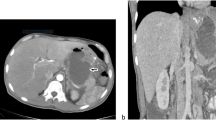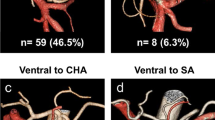Abstract
Background
In view of the descriptions of the CT manifestations on the greater omentum (GO) were not precise and detailed enough in the previous literature, we tried to evaluate the radiologic-anatomical features of the GO and to address the related clinical implications for the radiologic diagnosis and surgical application.
Methods
We evaluated the GO by using multi-detector row CT (MDCT) scanning in 50 individuals correlating with anatomical basis and clinical application. Emphasis was placed on the following items: the anatomical distribution and location of the GO; the CT manifestations of the vasculature, fatty tissue and lymph nodes.
Results
The gastro-epiploic vessel, the landmark for delineating the GO, was visualized in 50/50 cases (100%). The gastro-colic vein was detected in 34/50 cases (68%). The free-hanging portion, 48 cases revealed, seemed to have the capability of ‘migration’: it is located in the subphrenic spaces in 9/48 cases (19%) and distributed in the right lower quadrant predominantly in 10/48 cases (21%). Three-dimensional reformatted images, obtained in five cases, demonstrated the return of the gastro-epiploic vein distinctly. Lymph nodes were rarely detected within the GO.
Conclusion
The depicted omental vessels, visualized by using multi-planar reconstruction images together with three-dimensional reformatted images, played a crucial role in delineating the GO comprehensively. It can provide the valuable data for the radiologic diagnosis and surgical therapy planning including surgery of reconstruction, pancreas, portal hypertension as well as infections and neoplastic diseases.








Similar content being viewed by others
References
Bannister LH (1995) Greater omentum. In: Williams PL, Bannister LH, Berry MM (eds) Gray’s anatomy, 38th edn. Churchill Livingstone, Edinburgh, p 1742
Faria SC, Tamm EP, Dubrow R, David C, Loyer E, Herron D, Sawaf Y, Ball G, Silverman PM, Charnsangavej C (2004) Use of thin-section, multidetector row helical CT images for coronal oblique reformations for optimal visualization of structures in the hepatoduodenal ligament. Abdom Imaging 29:231–238
Honnef D, Wildberger JE, Das M, Hohl C, Mahnken AH, Barker M, Gunther RW, Staatz G (2006) Value of virtual tracheobronchoscopy and bronchography from 16-slice multidetector-row spiral computed tomography for assessment of suspected tracheobronchial stenosis in children. Eur Radiol 16:1684–1691
Hu H, He HD, Foley WD, Fox SH (2000) Four multidetector-row helical CT: image quality and volume coverage speed. Radiology 215:55–62
Jin H, Min PQ (2007) Computed tomography of gastrocolic ligament: involvement in malignant tumors of the stomach. Abdom Imaging 32:59–65
Liebermann-Meffert D (2000) The greater omentum. Anatomy, embryology, and surgical applications. Surg Clin North Am 80:275–293
Meyers MA (2000) Dynamic radiology of the abdomen—normal and pathological anatomy, 5th edn. Springer, New York, pp 15–289
Meyers MA, Volberg F, Katzen B, Abbott G (1973) Haustral anatomy and pathology: a new look. II. Roentgen interpretation of pathological alterations. Radiology 108:505–512
Okada M, Fukada J, Toya K, Ito R, Ohashi T, Yorozu A (2005) The value of drip infusion cholangiography using multidetector-row helical CT in patients with choledocholithiasis. Eur Radiol 15:2140–2145
Oliphant M, Berne AS (1982) Computed tomography of the subperitoneal space: demonstration of direct spread of intraabdominal disease. J Comput Assist Tomogr 6:1127–1137
Oliphant M, Berne AS, Meyers MA (1995) Direct spread of subperitoneal diseases into solid organs: radiologic diagnosis. Abdom Imaging 20:141–147
Pereira JM, Sirlin CB, Pinto PS, Jeffrey RB, Stella DL, Casola G (2004) Disproportionate fat stranding: a helpful CT sign in patients with acute abdominal pain. Radiographics 24:703–715
Prokesch RW, Schima W, Chow LC, Jeffrey RB (2003) Multidetector CT of pancreatic adenocarcinoma: diagnostic advances and therapeutic relevance. Eur Radiol 13:2147–2154
Puylaert JB (1992) Right-sided segmental infarction of the omentum: clinical, US, and CT findings. Radiology 185:169–172
Rubin GD, Shiau MC, Leung AN, Kee ST (2000) Aorta and iliac arteries: single versus multiple detector-row helical CT angiography. Radiology 215:670–676
Silverman PM, Kalender WA, Hazle JD (2001) Common terminology for single and multislice helical CT. Am J Roentgenol 176:1135–1136
Sompayrac SW, Mindelzun RE, Silverman PM, Sze R (1997) The greater omentum. Am J Roentgenol 168:683–687
Acknowledgment
We thank the committee of National Natural Sciences Foundation of China very much for the financial support to finish this work. This study complies with the current laws of China.
Author information
Authors and Affiliations
Corresponding author
Rights and permissions
About this article
Cite this article
Jin, H., Min, Pq., Yang, Zg. et al. A study of multi-detector row CT scan on greater omentum in 50 individuals: correlating with anatomical basis and clinical application. Surg Radiol Anat 30, 69–75 (2008). https://doi.org/10.1007/s00276-007-0283-4
Received:
Accepted:
Published:
Issue Date:
DOI: https://doi.org/10.1007/s00276-007-0283-4




